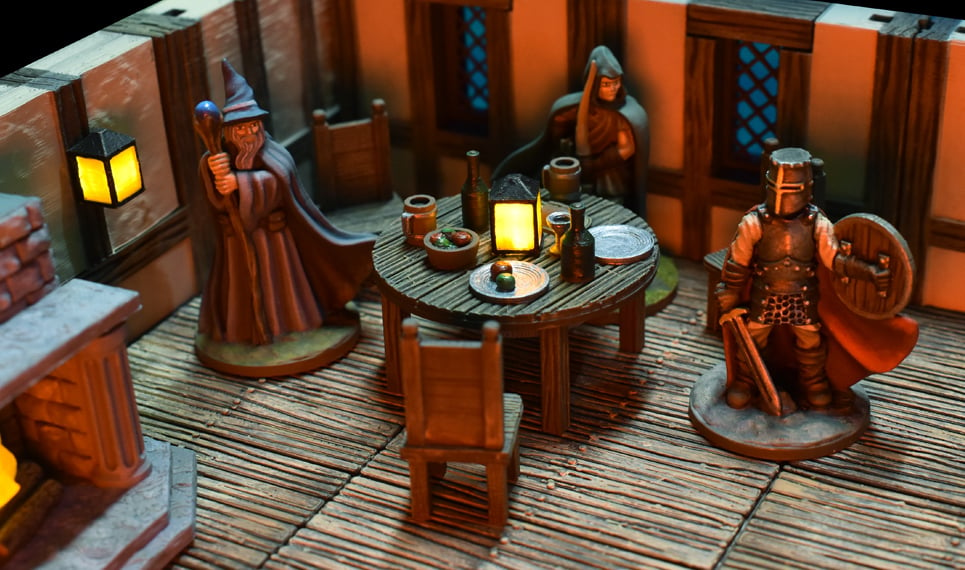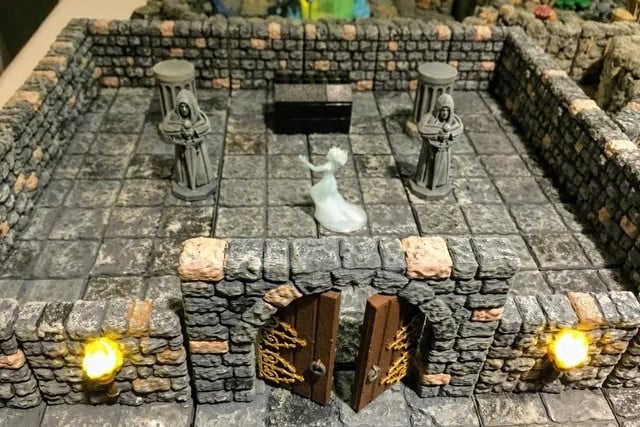In case you’re not familiar with them, tabletop role-playing games (TTRPGs) are a type of in-person game where players build and flesh out an epic story of heroism, villainy, bravery, cowardice, heartbreak, and more. They have been around since the mid-1970s when Gary Gygax published the first Dungeons & Dragons. Since then, the popularity of TTRPGs has only grown, with new players and game masters alike bringing their stories to life on the table. While early games were played with basic paper maps and tokens, now players can make use of three-dimensional terrain pieces such as buildings and interiors.
TTRPGs are amazingly cost-effective, offering hours of gameplay with little more than a pencil, a notepad, and a set of dice. Because of this, and because of the tendency for the game to change setting rapidly and without notice, many people chose to make “paper terrain”. As the name suggests, these are models of terrain made from paper, with many of the features drawn on by an artistic hand. As the popularity of the game grew, people started using models from tabletop wargames, train sets, and dioramas in their games. Eventually, some enterprising companies started producing terrain pieces specifically for TTRPGs. These mainly consisted of modular dungeon tiles, allowing game masters (players who act as narrators and referees) to build up a maze of interconnecting passages and rooms for their players to explore.
Fat Dragon Games is one company that produced paper terrain pieces with high-quality art and thorough instructions. Then, with the explosion in 3D printing, the company saw a unique opportunity to make even more immersive terrain accessible to its customers. They decided to start publishing digital models of a modular dungeon system for 3D printing, and the DragonLock system was born.
In this article, we’ll explore DragonLock and cover everything you need to know about 3D printing its dungeons and terrains. Of course, if you don’t have time to print the models, enlist the help of Craftcloud by All3DP for professionally printed pieces. Now, let’s get started!
DragonLock: What & Why
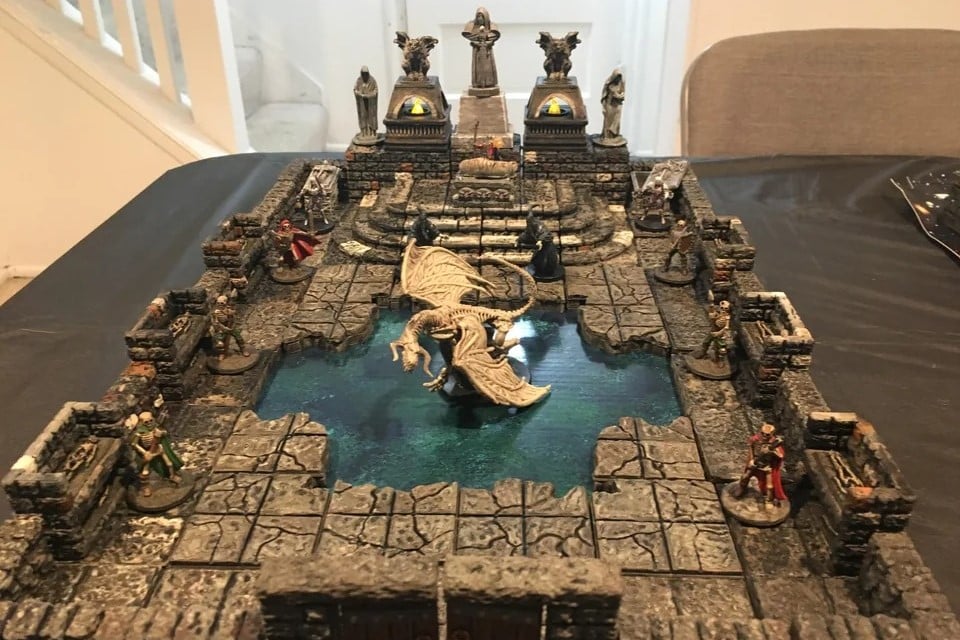
DragonLock is a modular dungeon system, meaning it can be used to build up large (or small) “dungeons”, which are usually labyrinthian structures where characters fight monsters and find treasure. In the case of DragonLock and most others, the system is composed of pieces that represent a 3 x 3-meter section of that dungeon (corresponding to four 1.5-square meter tiles). They include things like floors, walls, and other miscellaneous objects like doorways, stairs, and traps that connect together to create a close facsimile of the dungeon.
The DragonLock modular dungeon pieces come in a variety of styles, with dungeon, village, and even sci-fi themes. As the modules follow a standard format and connection system, even differently styled DragonLock pieces are compatible with each other. Simply insert a DragonBite 3D printed clip into one, then slide the two terrain pieces together until they click, and the modules are connected! To detach, simply slide them apart. The clips are quite strong, and you can easily move a smaller dungeon around as one piece.
Interestingly, DragonLock also publishes adapters to connect their tiles to alternative terrain systems, such as OpenLock and InfinityLock.
Versatility
While modular dungeon systems like DragonLock are marketed toward game masters, players who are hosting games, tabletop wargames enthusiasts, and miniature hobbyists looking to create dioramas (or just something interesting to paint) can all use DragonLock terrain.
DragonLock is geared mainly toward Dungeons & Dragons, published by Wizards of the Coast. However, it’s really suitable for almost any TTRPG, such as Pathfinder/Starfinder, The One Ring RPG, Mournblade (formerly Stormbringer), Warhammer Quest, and with the sci-fi Starships sets, just about any other TTRPG, including Star Wars RPG. It can also be used for Warhammer and other Games Workshop games, Warmachine and other Privateer Press games, and many other tabletop war games.
Really the only tabletop games that DragonLock’s range is not suited for are games that incorporate an industrial/post-industrial or modern/postmodern setting, such as the Bolt Action tabletop wargame or the D20 Modern ruleset. Call of Cthulu may also be a hard sell for DragonLock’s style. However, Fat Dragon Games does publish a paper scenery set of terrain for this style, so it’s easy to imagine they might release a DragonLock version in the near future.
Some other uses for DragonLock 3D printed terrain include the scenery around model train sets, particularly the village and outdoor sets. The terrain pieces can also be used to build dioramas. Lastly, the models can be used as toys for children, similar to toy soldiers.
Filament vs. Resin
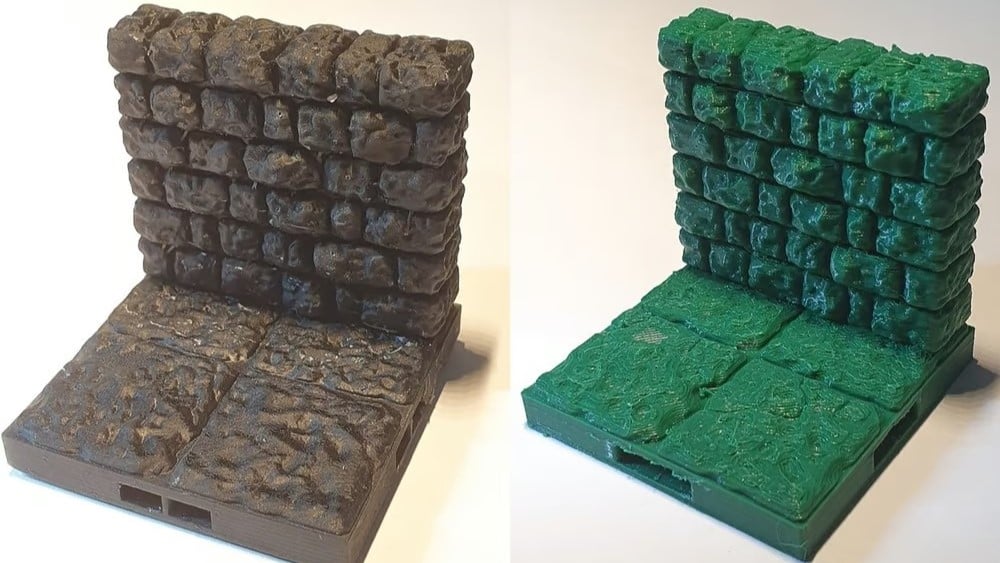
Here comes the fun part: 3D printing your terrain! Fat Dragon Games, the publisher of DragonLock terrain, encourages the use of a Creality Ender 3 and provides a Cura profile for Creality machines. Many in the 3D miniature printing space might disagree, as resin is typically considered best for miniature printing. That said, FDM is definitely no slouch, and when a model is designed with FDM in mind, the difference is negligible. This is particularly true for modular sections and large terrain pieces, which often have less detail than figurines.
To avoid confusion, from here on we’ll be using “figurine” to refer to player and monster pieces (like knights, wizards, or dragons), “modular section” to refer to modular terrain, and “terrain” to refer to things like trees or standalone items.
To quickly compare the cost of filament and resin in terms of time and money, we’ll look at one manufacturer who provides both. Anycubic PLA filament costs $29 per kilogram, and their Standard Resin is regularly $70 per kilogram. A modular wall section uses about 25 grams of filament, which means about $0.73 per wall section. The Fat Dragon Games standard-size figurine is around 5 grams, so about $0.15. Resin is significantly more expensive, at about $3 (~43 ml) for walls and $0.40 (~6 ml) for figurines.
Print Settings
For filament, we used the recommended print settings provided with the DragonLock STLs. They come with comprehensive instructions that cover filament selection all the way to painting. Here they are:
Modular Sections
- Layer height: 0.2 mm (0.1 mm for doors)
- Infill: 10%
- Top and bottom layers: 5 (1 mm)
Figurines
- Layer height: 0.1 mm
- Infill: 50%
- Top and bottom layers: 10 (2 mm)
- Outer wall speed: 24 mm/s
- Inner wall speed: 35 mm/s
- Travel speed: 120 mm/s
For resin, we used a standard resin profile for both terrain and figurines on the Anycubic Mono X as follows:
- Layer height: 50 microns
- Layer exposure time: 3.2 s
- Off time: 1 s
- Lift speed: 1 mm/s
- Lift height: 5 mm
- Bottom layers: 4 (at 30 s)
A modular wall section takes about four hours to print with resin and two with filament. In the case of resin, print times will vary wildly depending on the resin-printer combination you use, but to give you a rough indication, modular wall sections are around 1,120 layers, depending on your support settings. Neither resin nor filament needs much in the way of preparation before painting. However, as the FDM models are pre-supported, resin tends to need a little more care with support removal (and does need resin supports generated in the slicer). Once printed, you’ll need about 15 minutes to paint each modular wall section and 30 per figurine.
It should also be noted that, even if you decide to print your terrain in resin, the DragonBite clips must be printed in FDM, since cured resin is too brittle for the compliant clip to work. Given the increased expense and labor for little benefit, we cannot recommend resin for printing DragonLock terrain pieces. Additionally, the level of detail in the DragonLock figurines doesn’t require resin to achieve good results. That said, the final decision is of course up to you!
Pricing
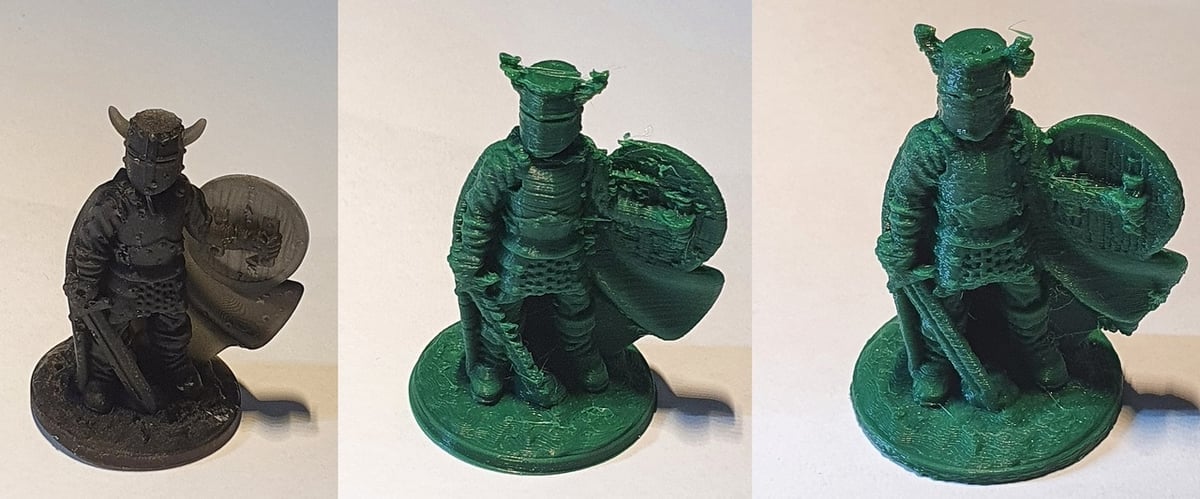
DragonLock files are delivered via digital download and come with instructions for printing. You can browse the official catalog on Fat Dragon Games’ website. When you go to purchase the files, you’ll be redirected to the official reseller DriveThru RPG. There you’ll also be able to browse many community content items that have been designed to work with the DragonLock System.
For most sets, including the starter set, the files are provided as STLs in a .zip, and they cost between $10 and $15. Larger or more complicated sets, such as their “Castle Starter” or the “DM Screen of Doom”, are more expensive, between $20 and $25. That said, DriveThru RPG does offer a significant amount of free items, such as Dungeon piece samples, figurines, and community-created content. This means you can try the system out before committing to purchasing sets of files. The .zip also includes instructions to help you get a great first print.
Community Thoughts
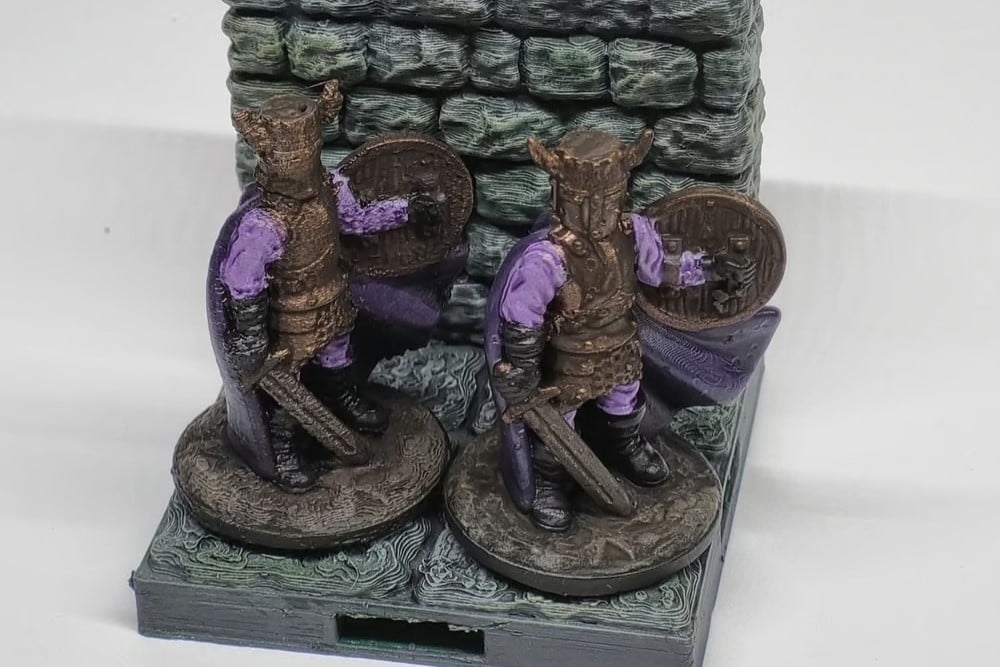
The first thing to mention about how TTRPG players feel about DragonLock and 3D printed terrain is that it’s not necessary for a good time. But more on that later. In general, terrain should make the game more fun and more immersive. However, there are a couple of common issues players experience with it.
First up is the wall problem. This refers to when you place a half-inch wall on a one-inch square and then have only a half-inch left for your figurine, which takes up a full one-inch square. This is compounded by the fact that each square is meant to represent the space occupied by one character or human-sized monster. It also leads to issues with using the majority of published or randomly generated dungeon maps. Luckily, Wyloch’s Armoury provides an excellent explanation and potential solution to the problem.
If you’re playing a TTRPG with dungeon terrain and it gets in the way of visualizing the action, it’s not doing its job. We play-tested a few encounters with DragonLock and found that the terrain was far too crowded when using regular-sized figurines. It blocked the view from some angles, and shorter walls may have been more usable.
During play-testing, we felt that DragonLock was better suited to embellishing encounters rather than building a complete dungeon. DragonLock does have scatter terrain – like treasure chests, bookshelves, and campfires – that would be excellent for these purposes. Their larger terrain pieces would also be excellent as focal points, but all in all, we felt that a table full of dungeon tiles was too crowded for effective play. That said, each game group is different, so play-testing with your own group is highly recommended!
There are a lot of positive comments about DragonLock from the community, and the quality of the sculpts is excellent. You can also find a few helpful tutorials on YouTube about 3D printing figurines, like the one from Tomb of 3D Printed Horrors. For added excitement, DragonLock also offers some clockwork pieces, such as sliding or rotating doors and moving traps, as well as pieces that support integrated LED lighting.
3D Printed Alternatives

Say you’re not sold on DragonLock, but you’re still interested in 3D printing some dungeon terrain. The good news is that there are plenty of other systems worth checking out. And again, since there are adapters available, you can mix and match as you please! Here are some 3D printable alternatives:
- OpenForge: OpenForge is free and compatible with any “OpenLock” terrain system and DragonLock through an adapter.
- Printable Scenery: Printable Scenery has the widest variety, although DragonLock is close. They also have a lot of buildings and set pieces that aren’t dungeon tiles if that’s what your group prefers.
- True Tiles: True Tiles solves the wall problem by using a 1.25-inch tile. They also come with shorter walls as standard to allow a less cluttered dungeon. Some people feel these are too short and don’t create as much interest as a taller wall with more detail.
- Dragon’s Rest: Dragon’s Rest can be gained through a Patreon subscription, meaning frequent scheduled updates and new scenery. Don’t worry, though, their old sets are also available for separate purchase. Dragon’s Rest also solves the wall problem by using 1.5-inch tiles and lower walls, though these are a little higher than the True Tiles walls.
While it’s a bit dated, Gaminggeek has an excellent video comparing several 3D printed dungeon terrain options.
Other Alternatives
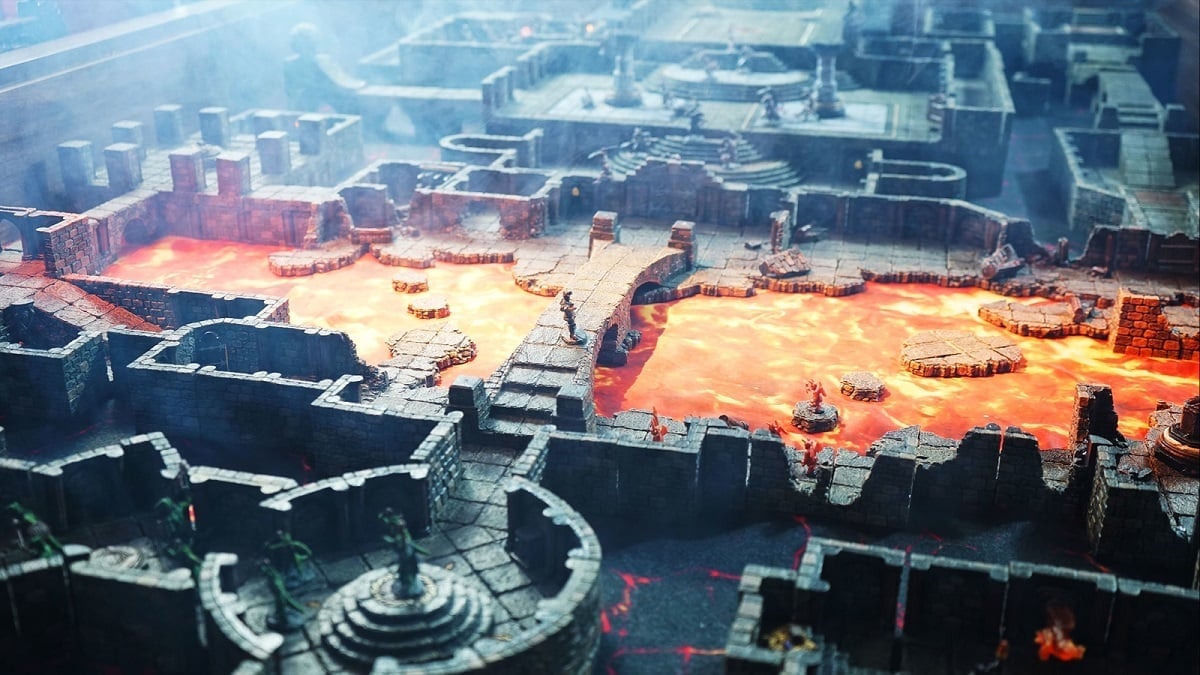
If you’re not ready to take the plunge into 3D printed terrain (because perhaps you have a backlog of figurines to print), there are other options.
One solution is boxed terrain sets like Dwarven Forge, which let you purchase professionally crafted and painted terrain. Beware, it’s expensive! If you would prefer to save some money but still do it yourself (perhaps while waiting for your GM Screen of Doom to print), you could try crafting your own terrain using hot glue and cardboard, as described by Knarb Makes and Wyloch’s Armory.
Another 3D solution is paper terrain, which is also available from Fat Dragon Games. This is 3D terrain constructed from printed paper. It has the benefit of being cheap, which is ideal if your games tend to change location every session and you regularly need to rebuild your terrain library.
Next up, we have some 2D options. These are simple maps printed at a printing service, hand-drawn, or printed at home that can help illustrate the situation to your games group. Throw in some 3D printed scatter pieces like furniture and traps, and you have a wonderfully immersive table without any terrain obstructing play. You may also consider digital solutions such as Owlbear Rodeo, Fantasy Grounds, or Roll20. These are particularly effective if you mount a monitor at your table.
Lastly, the cheapest and most flexible solution is simply using your imagination. This is extremely handy when your party decides to board a ship rather than enter the dungeon you’ve just printed for your gaming session.
License: The text of "DragonLock: How to 3D Print Dungeons & Terrains" by All3DP is licensed under a Creative Commons Attribution 4.0 International License.

